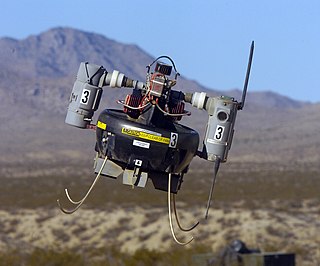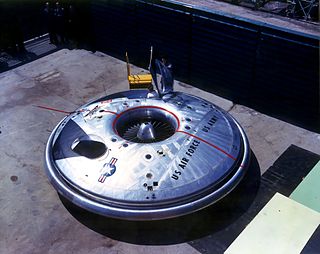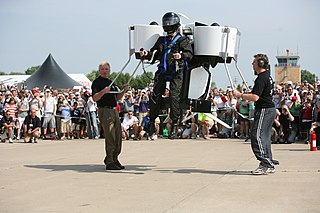
An aircraft is a vehicle that is able to fly by gaining support from the air. It counters the force of gravity by using either static lift or the dynamic lift of an airfoil, or, in a few cases, direct downward thrust from its engines. Common examples of aircraft include airplanes, helicopters, airships, gliders, paramotors, and hot air balloons.

A flying car or roadable aircraft is a type of vehicle which can function both as a road vehicle and as an aircraft. As used here, this includes vehicles which drive as motorcycles when on the road. The term "flying car" is also sometimes used to include hovercars and/or VTOL personal air vehicles. Many prototypes have been built since the early 20th century, using a variety of flight technologies. Most have been designed to take off and land conventionally using a runway. Although VTOL projects are increasing, none has yet been built in more than a handful of numbers.
A vertical take-off and landing (VTOL) aircraft is one that can take off and land vertically without relying on a runway. This classification can include a variety of types of aircraft including helicopters as well as thrust-vectoring fixed-wing aircraft and other hybrid aircraft with powered rotors such as cyclogyros/cyclocopters and gyrodynes.
Aviation is the design, development, production, operation, and use of aircraft, especially heavier-than-air aircraft. Articles related to aviation include:

A micro air vehicle (MAV), or micro aerial vehicle, is a class of man-portable miniature UAVs whose size enables them to be used in low-altitude, close-in support operations. Modern MAVs can be as small as 5 centimeters - compare Nano Air Vehicle. Development is driven by commercial, research, government, and military organizations; with insect-sized aircraft reportedly expected in the future. The small craft allow remote observation of hazardous environments or of areas inaccessible to ground vehicles. Hobbyists have designed MAVs for applications such as aerial robotics contests and aerial photography. MAVs can offer autonomous modes of flight.

A tail-sitter, or tailsitter, is a type of VTOL aircraft that takes off and lands on its tail, then tilts horizontally for forward flight.

A jet pack, rocket belt, rocket pack or flight pack is a device worn as a backpack which uses jets to propel the wearer through the air. The concept has been present in science fiction for almost a century and the first working experimental devices were demonstrated in the 1960s.

The Convair XFY-1 Pogo was an experimental V/STOL aircraft developed during the early years of the Cold War. It was intended to be a high-performance fighter aircraft capable of operating from small warships. Lockheed and Convair were awarded contracts to build experimental VTOL fighters, with Convair producing the XFY-1, also known as the "Pogo." It was developed as an attempt to create a practical V/STOL aircraft.

The Avro Canada VZ-9 Avrocar was a VTOL aircraft developed by Avro Canada as part of a secret U.S. military project carried out in the early years of the Cold War. The Avrocar intended to exploit the Coandă effect to provide lift and thrust from a single "turborotor" blowing exhaust out of the rim of the disk-shaped aircraft. In the air, it would have resembled a flying saucer.

On a helicopter, the main rotor or rotor system is the combination of several rotary wings with a control system, that generates the aerodynamic lift force that supports the weight of the helicopter, and the thrust that counteracts aerodynamic drag in forward flight. Each main rotor is mounted on a vertical mast over the top of the helicopter, as opposed to a helicopter tail rotor, which connects through a combination of drive shaft(s) and gearboxes along the tail boom. The blade pitch is typically controlled by the pilot using the helicopter flight controls. Helicopters are one example of rotary-wing aircraft (rotorcraft). The name is derived from the Greek words helix, helik-, meaning spiral; and pteron meaning wing.

A backpack helicopter is a helicopter motor and rotor and controls assembly that can be strapped to a person's back, so they can walk about on the ground wearing it, and can use it to fly. It uses a harness like a parachute harness and should have a strap between the legs. Some designs may use a ducted fan design to increase upward thrust. Several inventors have tried to make backpack helicopters, with mixed results.

A gyrodyne is a type of VTOL aircraft with a helicopter rotor-like system that is driven by its engine for takeoff and landing only, and includes one or more conventional propeller or jet engines to provide forward thrust during cruising flight. During forward flight the rotor is unpowered and free-spinning, like an autogyro, and lift is provided by a combination of the rotor and conventional wings. The gyrodyne is one of a number of similar concepts which attempt to combine helicopter-like low-speed performance with conventional fixed-wing high-speeds, including tiltrotors and tiltwings.

The Rockwell XFV-12 was a prototype supersonic United States Navy fighter which was built in 1977. The XFV-12 design attempted to combine the Mach 2 speed and AIM-7 Sparrow armament of the McDonnell Douglas F-4 Phantom II in a VTOL fighter for the small Sea Control Ship which was under study at the time. On paper, it looked superior to the subsonic Hawker Siddeley Harrier attack fighter. However, it was unable to demonstrate an untethered vertical takeoff and its inability to meet performance requirements resulted in the program's termination.
The Garrett STAMP was a two-person aircraft prototype made by a division of AiResearch Manufacturing Co. of Phoenix, Arizona, for the United States Marine Corps STAMP program, in the early 1970s.

The Martin Jetpack was a single-person aircraft under development. Despite its name, it did not use a jet pack as such, but ducted fans for lift. Martin Aircraft Company of New Zealand developed it, and unveiled it at the Experimental Aircraft Association's 2008 AirVenture in Oshkosh, Wisconsin, US. The US Federal Aviation Administration classified it as an experimental ultralight airplane.
Trek Aerospace Inc is a small engineering company based in Folsom, California, United States. Despite its name, Trek Aerospace currently manufactures only terrestrial ducted-fan-powered aircraft and watercraft. The company's products have received some media attention, particularly its ducted-fan based "jetpacks", an exoskeleton mounted with dual ducted-fan propulsion, such as the Springtail model.

The Aerial Reconfigurable Embedded System (ARES) was a concept for an unmanned VTOL flight module that can transport various payloads. The concept started as the TX (Transformer) in 2009 for a terrain-independent transportation system centered on a ground vehicle that could be configured into a VTOL air vehicle and carry four troops. ARES' primary function was the same as TX, to use flight to avoid ground-based transportation threats like ambushes and IEDs for units that don't have helicopters for those missions. It was to be powered by twin tilting ducted fans and have its own power system, fuel, digital flight controls, and remote command-and-control interfaces. The flight module would have different detachable mission modules for specific purposes including cargo delivery, CASEVAC, and ISR. Up to 3,000 lb (1,400 kg) of payload would be carried by a module.

The XTI TriFan 600 is a vertical takeoff and landing aircraft currently under development by XTI Aircraft Company. The TriFan 600 is referred to as a Vertical Lift Crossover Airplane (VLCA) by XTI to differentiate its range and speed from the many short-range, low-speed electric VTOL (eVTOL) aircraft under development.














